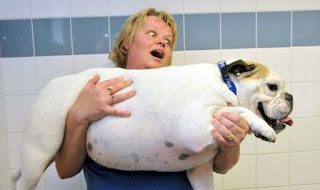A Clean Pet
Every top-quality stylist knows the importance of a clean pet. It is impossible to obtain a satin-smooth finish on a pet that has a dirty or filmy coat. On most pets, two baths with the correct
shampoo are normally considered adequate to produce a squeaky-clean coat. Rinsing the pet thoroughly is critical to avoid shampoo residue that looks oily on a dry coat and produces a film you can feel on your hands.
#1 The Drying Process
The goal is to dry the coat so there is absolutely no curl or wave left in it. The natural coat of the pet whether curly wavy or straight - will determine which drying process will achieve the desired result. Correct use of a high-velocity dryer can effectively produce a straight coat. Heat will "set" the coat straight. In some cases, the heat of the high-velocity dryer, without the condensing cone, held against the skin in the final stages of drying will produce the desired effect. With very curly coats, hand stretch drying or hand lift drying the coat using a stand type or hand-held dryer is necessary
Curly coats need to be as straight as possible in order to achieve a smooth, high-quality finish. With a higher level of heat from the drying source, it is important to keep the air moving within a small section while brushing in very rapid, light strokes, up to one to four strokes per second, just where the air is blowing. This will straighten the coat, just as a curling iron would curl a strand of human hair.
#2 Back Brushing
Back brushing is done with a slicker brush while brushing the coat against the grain. The pressure on the brush should be very light and the entire pad of the brush should make contact with the skin and coat. Keep the pressure light on the brush so the skin is not scraped, causing a potential "brush burn." Back brush the entire coat once and make a clipper pass over the pet using effective techniques. When the bulk of the coat is gone, repeat the process a second time to get a smoother finish. On the third back brush pass, look only for high spots or uneven areas. Minimize the number of passes with the clipper. otherwise, the setup coat will be cursed.
On drop-coated breeds, when a #1.5 or a #1 guard is used to clip the pet, a "body roll" is normally more effective than back brushing. The body roll simulates the natural shake of a dog, setting up the coat in its most natural position Ideally, the pet will shake when it is placed on the table. Take advantage of this and make the first full pass with the clipper. If the pet does not shake when it is first set on the table, sometimes simply blowing lightly in its ear will encourage a natural shake. A body roll can be mimicked by standing behind the dog and grasping a small amount of coat, low on either side of the rib cage. Tug one side and then the other, making the skin and coat rock back and forth as it would in a natural shake. Most pets do not find this move uncomfortable as long as it is done quickly




Comments
Post a Comment